Wear a life jacket and know cold water safety facts
May 06, 2020 12:41PM ● By Editor
Dangerous Cold Water Safety
Warm air doesn’t necessarily mean the water is warm. Survival time is greatly diminished for someone immersed in water below 70 degrees. Warm air temperatures can create a false sense of security for boaters and beach goers. Cold water drains body heat up to 25 times faster than cold air. When cold water makes contact with your skin, cold shock causes an immediate loss of breathing control. This dramatically increases the risk of sudden drowning even if the water is calm and you know how to swim. The danger is even greater if the water is rough. Immersion in cold water is immediately life-threatening for anyone not wearing thermal protection, like a wetsuit or drysuit, and not wearing a life jacket.
Facts
- Roughly 20 percent of those who fall into cold water die in the first minute of immersion due to cold water shock.
- Even strong swimmers will lose muscle control in about 10 minutes.
- Body heat can be lost 25 times faster in cold water than in cold air.
- Wearing a life jacket significantly increases chances of survival.
Body’s Reaction to Cold Water
Knowing some basic cold water immersion principles can greatly increase your chances of survival. Although the times are approximate, in general you should try to remember the 1-10-1 Principle.
The 1-10-1 Principle of Cold Water
0-1 minute........COLD SHOCK / RAPID BREATHING
In 10 minutes...LOSS OF MUSCLE CONTROL
In 1 hour...........HYPOTHERMIA
1 Minute to Control Your Breathing
You have one minute after being submerged in water to get your breathing under control and realize what has happened. This is due to the “cold shock” of the water temperature -- which causes involuntary gasping, making it hard to catch your breath. If breathing isn’t controlled immediately, the possibility of drowning drastically increases. Many people hyperventilate, faint, and drown before they are able to calm down their breathing.
10 Minutes of Muscle Control
After gaining your awareness, your body has about 10 minutes of meaningful movement. After that, it’s likely the cold water temperatures will cause a loss of control over hands, arms, and legs -- and you won’t be able to swim. If you can’t get out of the water within 10 minutes, stop moving and get into the Heat Escape Lessening Position (H.E.L.P. - see Take Action section below). Movement will deplete your energy faster and increase heat loss.
1 Hour Until Hypothermia
There is approximately one hour until hypothermia will set in. Hypothermia is a condition in which the body loses heat faster than it can produce it -- this can cause violent shivering, unconsciousness, or cardiac arrest. Keep in mind that most cold water deaths occur well before this point -- only those wearing a life jacket will survive longer than 10 minutes in most cases.
The phrase 1-10-1 Principle was coined by Dr. Gordon Giesbrecht. The descriptions above are based on material from the U.S. Coast Guard, the U.S. Army Corps of Engineers, and the National Park Service.
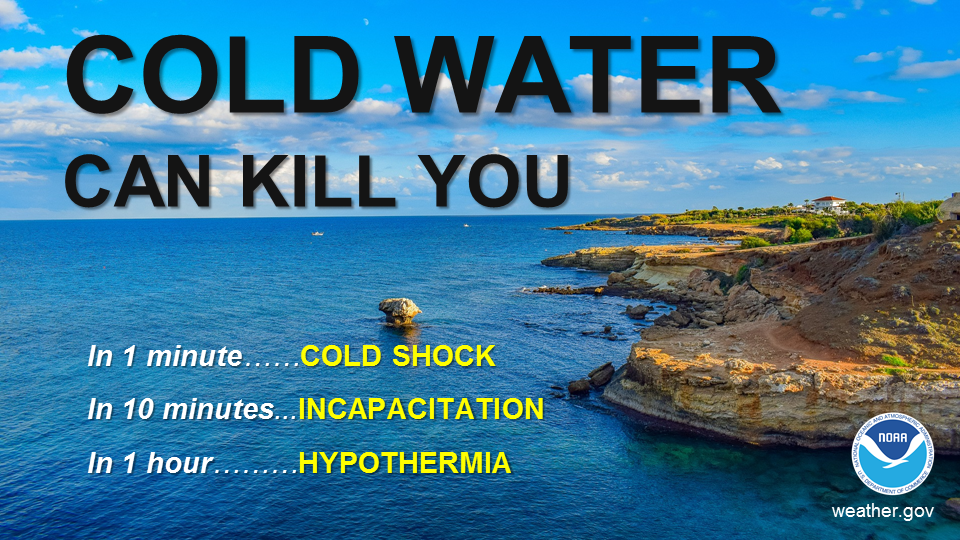
Risks
Cold water risks include immersion into both cold coastal and cold inland waters. Warming weather conditions can be deceiving. While air temperatures warm, water temperatures can still remain cold. A typical scenario would be for a mild sunny and calm morning that draws many to the water. As the day progresses the wind comes up and waves build. This results in an enhanced risk of people falling into or overturning into these cold waters, resulting in the threat of cold shock and a high risk of drowning. Ocean currents including rip currents enhance these threats. Water activities that put people at risk include kayaking, canoeing, whitewater rafting, paddle boarding, and lake boating.
Risks that may cause immersion in cold water include:
- Turbulent water, waves and surf which can overturn watercraft or fill boat with water.
- Falling off watercraft, docks, rocks or jetties.
- Falling through the ice.
- Sneaker waves that can pull beach walkers into surf.
- Rising tides, rising rivers, tidal currents and rip currents.
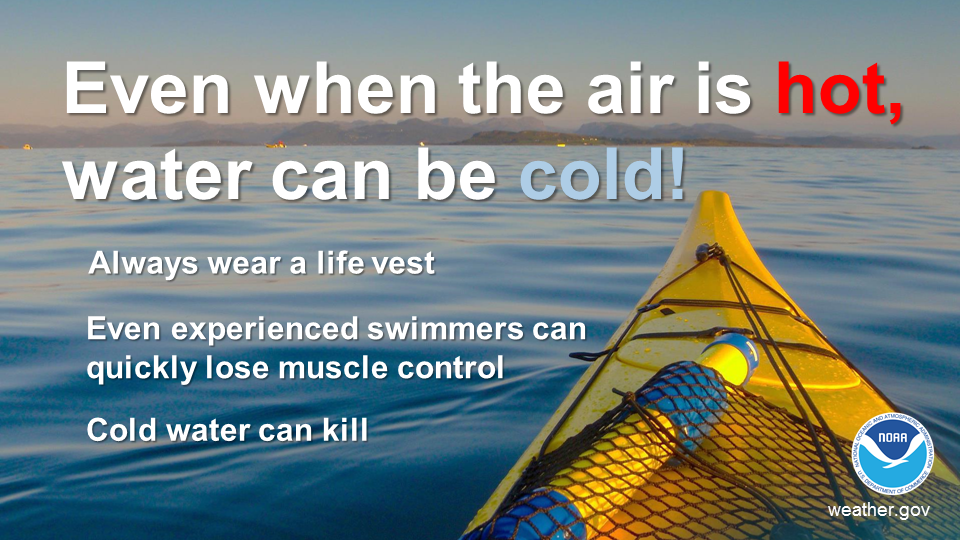
–Preparedness
Being prepared for an outing on cold water means being prepared for the possibility of suddenly being immersed into cold water. Your ability to survive cold water immersion depends on your ability to stay afloat and to stay warm until help arrives. Below are several things to consider prior to venturing out on cold water.
- Always wear a Life Jacket
- Wear cold water protection gear for the water temperature, not air temperature
- Some examples are:
- Wet suit
- Dry suit
- Immersion suit
- Survival suit
- Exposure coveralls
- Carry an Emergency Position Indicating Radio Beacon (EPIRB )
- File a float plan with someone you trust. The plan should include details about the trip, boat, passengers, towing or trailer vehicle, communication equipment, and emergency contacts.
- Know Before You Go:
- Be sure to check the weather before you go out on the water and check the water temperature
- If water is too cold, consider staying off/out of water until water is warmer
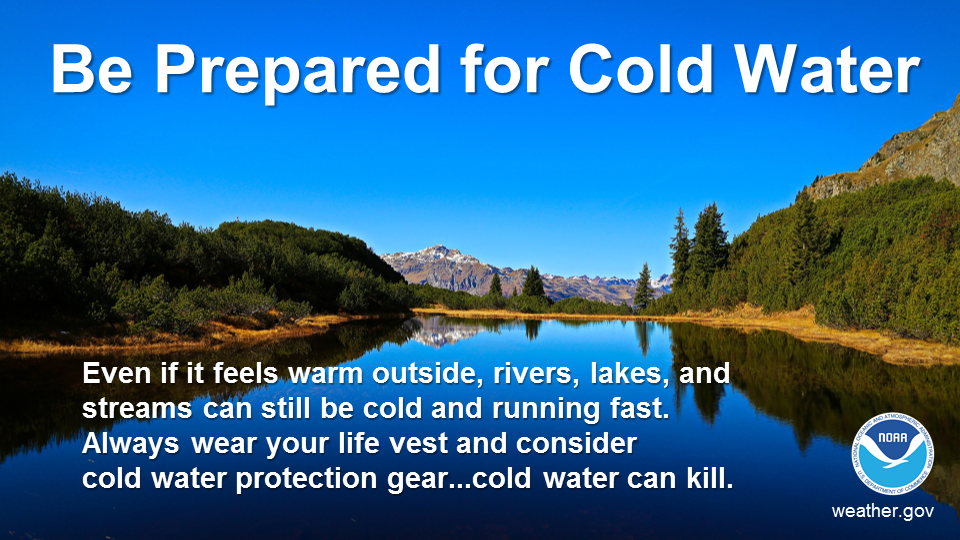
–Take Action
Cold water can kill. The following guidelines and images from the U.S. Coast Guard will increase your chance for survival:
- Stay calm. Evaluate your situation and control your breathing.
- Minimize time in the water. Get out as soon as possible safely.
- If possible, utilize any floating objects to get out of the water.
- Keep as much of your body out of the water.
- Evaluate your options.
- If you can swim to safety, stay calm. Do not swim aimlessly because you can lose heat quickly.
- If you cannot swim to safety, conserve energy and heat and await rescue.
- If you cannot get to safety, assume the Heat Escape Lessening Position (H.E.L.P.) position. This protects the critical body areas and slows down the loss of heat. H.E.L.P position means:
- Draw your knees to your chin and keep your legs together.
- Press both arms against your side and keep your head out of the water.
- If possible, form a huddle in the water with others to conserve body heat.
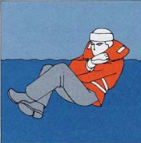 H.E.L.P. | 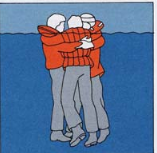 Huddle position |
If you need to treat yourself or someone else that has been submerged in cold water, follow the steps below (developed by the Red Cross):
- CALL 911 or the local emergency number.
- Gently move the person to a warm place.
- Monitor breathing and circulation. Give rescue breathing and CPR, if needed.
- Remove any wet clothing and dry the person.
- Warm the person slowly by wrapping in blankets or by putting on dry clothing.
- Hot water bottles and chemical hot packs may be used. Wrap the person in a towel or blanket before applying.
- Do not warm the person too quickly. Do not immerse the person in warm water. Rapid warming may cause dangerous heart arrhythmias.
- Warm the core first (trunk and abdomen), not the extremities (hands, feet). Warming hands and feet first and can cause shock.

